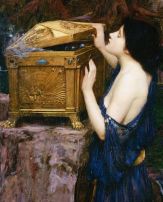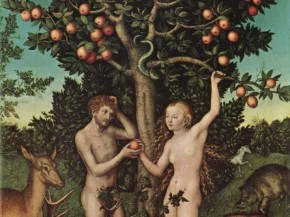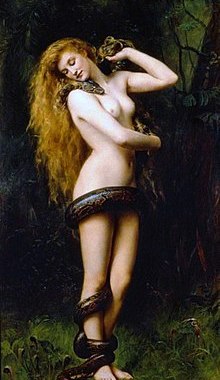by K.P. Kulski
When taking a deeper look into the stories of Lilith and Eve, understand that organized religion was an important part of creating order within early civilizations. When I say “civilization” I’m referring to settled towns and cities that are permanent places of human dwelling. In the prehistoric world human life was mostly nomadic in nature, with belief systems that fit into that lifestyle.
The Ancient Greeks, a significant influence on Western social ideas concerning

patriarchy (that’s a whole other article to explain), asserted that women needed to be restrained for the good of civilization. “Zeus eventually puts an end to the successive overthrowing of kings by conspiracies of wives and sons. Establishing a patriarchal government on Olympus. Zeus introduces moral order and culture…”[1] They believed that women were more animal-like, subject to base instincts, sexually wild and would destroy civilization if not properly controlled.[2] As my friend E.J. likes to say, “social ideal does not equal social reality,” so certainly there are plenty of examples of women in Ancient Greek society who were not at all controlled.
But the idea was there. If there is a fear that women can dismantle civilization, what role

did women play before civilization was established? As evidenced by Lilith, early civilizations like both the Ancient Greeks and the Israelites expressed concern over patriarchal order, which became synonymous with civilized order. Nomadic groups became “barbaric” and “uncivilized.” In these early groups women seemed to have had at least a place of respect, if not reverence or even dominance.
Could Lilith and Eve’s story have more to do with the fear of the ruin of civilization and a return to equality of the genders?

Many of the earliest artifacts found in and around Europe, Asia Minor and the Middle East depict an array of what is known as Venus figurines dating from this prehistoric time period.
Don’t let the name mislead you, these figurines have little to do with the Roman goddess Venus. Instead these date from prehistory, the Paleolithic to the Bronze Age, a time long before the Roman Republic. Most famous (and bearing the same misleading name) is the Venus of Willendorf. The depictions of women are carved from stone, antlers, bones or shaped from clay and fired.
So why am I talking about all this? You thought this was an article about rebellious women? Bear with me.
These figurines may represent something far bigger than the shape of a woman crafted into the perfect handheld icon. Certainly, the exaggerated focus breasts, hips and the pubic triangle, seem to indicate that these were for fertility,

but this not certain. It is important to note that these figurines are found throughout Europe – Germany, Austria, Italy, France and Russia to name a few. Further, they have strong connections to other symbols and figurines found in the early Mediterranean cultures like the Minoans of Crete and places like Çatalhöyük in Turkey. These connections and the wide-ranging areas they have been discovered may indicate something much bigger than reverence of fertility alone. They could represent a social ideal, a wide-spread reverence for womanhood—sacred

womanhood, socially equal, or even superior womanhood.None of this is definitive, but the sheer amount of Venus figurines point to something focused on women.
In Jewish mythology, Lilith was the first woman created by God. The earliest written form of her story appears in the early Middle Ages (between the 8th to 10th centuries), but is much older. It is no surprise however, that it was written during a time that marked significant struggles for new social orders. As Adam’s wife, Lilith refused to have sex in the missionary position saying to Adam, “We are equal to each other inasmuch as we were both created from the earth.”[3] Before you get caught up in the Kama Sutra of sexual positions, realize the story has much more to do with social dominance. Lilith didn’t just have a problem with how she and Adam engaged in sex, she had a problem with the inherent idea that she was, “fit only to be in the bottom position, while I (Adam) am to be the superior one.”[4] When Adam refused to treat her as an equal, Lilith left him with all the credit card bills and the Garden of Eden mortgage and went out to find herself in the great unknown of the world beyond.
So here we are, Lilith decided she was equal and wasn’t going to put up with Adam’s ideas of superiority. Not so demonic is that? Ok hold on to this information, you’re going to need it to put together the pieces of what the conflict was really all about.
Adam complained to God, “the woman you have given me has run away.”[5] Note the concept here that Adam has ownership over Lilith as seemed sanctioned by God. So Lilith ran away and God seemed compelled to “give” Adam another wife.
Then came Eve.
Lilith isn’t in the Bible, but Eve is and unlike Lilith, Eve is rather cooperative with Adam. She doesn’t spend much time fighting with him and seems to accept her relative lower  position. However, Eve is ultimately tempted and finally eats the forbidden fruit. When she does this, she was not transgressing Adam, instead she was transgressing God by accessing the Tree of Knowledge he has forbidden. God in these stories is the ultimate male power who has exerted order and established a great place to live (i.e. civilization). Eden has inadvertently rejected the social ideal of her subservience, by not only disobeying God, but also through the desire and obtainment of knowledge. Because of Eve’s disobedience (and of course Adam too) they are cast out of Eden.
position. However, Eve is ultimately tempted and finally eats the forbidden fruit. When she does this, she was not transgressing Adam, instead she was transgressing God by accessing the Tree of Knowledge he has forbidden. God in these stories is the ultimate male power who has exerted order and established a great place to live (i.e. civilization). Eden has inadvertently rejected the social ideal of her subservience, by not only disobeying God, but also through the desire and obtainment of knowledge. Because of Eve’s disobedience (and of course Adam too) they are cast out of Eden.
Oh no! A woman has caused destruction of civilization that the Ancient Greeks feared.
The mythological Lilith became a demonic power after leaving Adam. There are many forms her legend has taken over the ages – the cause of sickness in infants, an evil spirit, a lamia, a spirit that brings death and destruction, a succubus and a hyper-sexualized temptress that brings ruin to men who can’t help but desire her. Sometimes all or some of these ideas are wrapped together. These concepts of Lilith go all the way back to Sumer, indicating that Lilith was a shared cultural idea, as the prehistoric Venus figurines were a shared cultural idea.
The metamorphosis and focus on Lilith’s refusal to adhere to the social order set out before her, indicates a strong patriarchal reaction to (at the very least) a much more egalitarian value system between genders. With the establishment of civilization and increasing successful births rates due to settled lifestyles, the importance of woman waned before the need for a definitive social order in the face of the increased population centers. With the increase of things to own and wealth to accumulate (things difficult to do in a nomadic culture), a system of inheritance rose up. No longer could possessions be passed communally since communities were much too large in this structure. Familial relations over community relations become more important for the purpose of passing on goods and property. In order to determine familial relations, a formal system of mating (marriage) had to be established as well. In a patriarchal structure this amounted to essentially ownership over their spouse(s) as well as their offspring.
So…
Lilith is what happens when a woman refuses to accept a lower position.
Eve is what happens when a woman desires knowledge.
A whole lot of blame. (Really Adam you couldn’t just be bottom sometimes?)
Ultimately, Lilith isn’t quite the demon she is made out to be. Eve isn’t quite the betrayer she is made out to be. Instead they represent some of the earliest fears of female agency.
Arguments we continue to hear today when women’s rights are discussed, argued over and… well, are also demonized.
_______________________________________________________
Endnotes
[1] Sarah B. Pomeroy, Goddesses, Whores, Wives, and Slaves. (New York: Schocken Books, 1975) 2.
[2] “But the woman took off the great lid of the jar with her hands and scattered all these and her thought caused sorrow and mischief to men.” “Pandora: Hesoid, Works and Days.” Theoi Greek Mythology, Accessed 02 June 2018. http://www.theoi.com/Heroine/Pandora.html
[3] “The Alphabet of Ben Sira: The Story of Lilith.” trans. Norman Bronznick. Jewish and Christian Literature, Accessed 02 June 2018. http://jewishchristianlit.com/Topics/Lilith/alphabet.html
[4] Ibid.
[5] Ibid.
